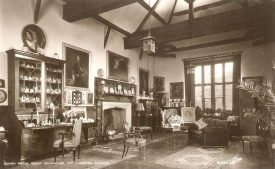LGBTQ+ histories are often called ‘hidden histories’, but when we uncover them we can find that familiar places come alive with even more stories. For example, who would have thought that the gatehouse at Kenilworth Castle had a hidden homosexual history? Who knew that it played host to an attempt by policemen to entrap its gay/bisexual inhabitant?
A fake tourist and an illicit tour
Arthur Laxton Hames, aged 49, was an antiques dealer and the occupant of the gatehouse at Kenilworth Castle. He moved there in around 1921, having previously lived in Leicestershire.1 Hames was married to a woman with disabilities, who said that their life together had been ‘very happy indeed’ and they had hardly ever been separated.2 He ran the gatehouse as a paid visitor attraction, with a restaurant and the sale of works of art. It was in the disguise of a tourist that P.C. Bertie Toombs first made his acquaintance with Hames, in July 1933.
Toombs was pretending to prepare notes for a lecture and visited the gatehouse for a tour. He was observed in the cafe by Hames. When he returned the next day, Hames said he need not pay and offered to give him a tour himself. They viewed various portraits and then went up to the guard room and through into Hames’ study. Hames showed Toombs some books with titles like ‘Lads of the Sea’ and then an ‘alleged assault’ took place.3 Hames was charged with the assault, but this particular case did not reach trial as there was no corroborative evidence. The counsel were very critical of the police’s ‘trap’, describing it as ‘diabolical’ and stating that ‘there were too many cases nowadays in which police officers assumed disguises not only to observe crime but to assist in its manufacture’.4
Another attempt
However, the effort by the local police to ‘trap’ Hames seems to have been a concerted one. Toombs was not the first police officer to have dealings with Hames at the Kenilworth gatehouse. The previous month, P.C. George Scown visited him in the middle of the night on a number of occasions. The first time was to collect evidence for an unrelated but urgent case, but then he returned at around 1am for a number of nights. On one of the occasions, another ‘alleged assault’ took place.5 Scown continued visiting to ‘see what sort of man Hames was.’6 Hames was apparently quite unreserved, purportedly telling Scown that ‘I should have liked to… see you come out of the water all naked and bashful’, that he thought he would like to be king of a nudist colony, and that he would ‘love to be the mother’ of Scown’s sons.7 Scown said that the incidents made him feel embarrassed, nervous and disgusted, but that he was acting on instructions.8 Hames denied the whole thing as an ‘invention’.9
‘Fighting for his life’
Hames was arrested in the gatehouse whilst conversing on the settee with Toombs. He was found to have in his possession a nude photograph and an ‘indecent’ pipe stopper, which he felt would prejudice people against him.10 His response to being charged was to say ‘this is terribly interesting’.11 At trial, the defense lawyer stated that Hames was ‘fighting for his life’ because, if found guilty, he ‘could never look at his fellow citizens again’.12 After 15 minutes deliberation, the jury found Hames guilty. The defense counsel requested that Hames be put through ‘medical treatment’ which would ‘get him out of the habit in six months’.13 Hames was instead sentenced to a period of imprisonment.
References
1 1911 Census; Leicestershire & Rutland, Kelly’s Directory, 1928; Electoral Register, Parliamentary Borough of Leicester, South Division, 1929.
2 ‘Grave Charges Against Kenilworth Resident’, Leamington Spa Courier, 24 November 1933.
3 ‘Police methods criticised’, Leamington Spa Courier, 18 August 1933; ‘Serious charges against Kenilworth men’, Leamington Spa Courier, 21 July 1933; ‘The charge against Arthur Laxton Hames’, Warwick & Warwickshire Advertiser, 19 August 1933.
4 ‘Police methods criticised’, Leamington Spa Courier, 18 August 1933; ‘The charge against Arthur Laxton Hames’, Warwick & Warwickshire Advertiser, 19 August 1933.
5 ‘All-day hearing of Kenilworth case’, Warwick & Warwickshire Advertiser, 12 August 1933.
6 ‘All-day hearing of Kenilworth case’, Warwick & Warwickshire Advertiser, 12 August 1933; ‘Grave Charges Against Kenilworth Resident’, Leamington Spa Courier, 24 November 1933.
7 ‘All-day hearing of Kenilworth case’, Warwick & Warwickshire Advertiser, 12 August 1933; ‘Grave Charges Against Kenilworth Resident’, Leamington Spa Courier, 24 November 1933.
8 ‘All-day hearing of Kenilworth case’, Warwick & Warwickshire Advertiser, 12 August 1933; ‘Grave Charges Against Kenilworth Resident’, Leamington Spa Courier, 24 November 1933.
9 ‘Grave Charges Against Kenilworth Resident’, Leamington Spa Courier, 24 November 1933.
10 ‘The charge against Arthur Laxton Hames’, Warwick & Warwickshire Advertiser, 19 August 1933.
11 ‘All-day hearing of Kenilworth case’, Warwick & Warwickshire Advertiser, 12 August 1933.
12 ‘Grave Charges Against Kenilworth Resident’, Leamington Spa Courier, 24 November 1933.
13 ‘Grave Charges Against Kenilworth Resident’, Leamington Spa Courier, 24 November 1933.









Comments
Add a comment about this page